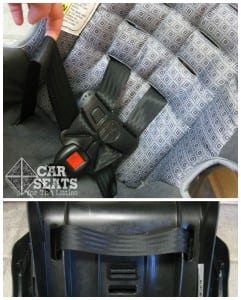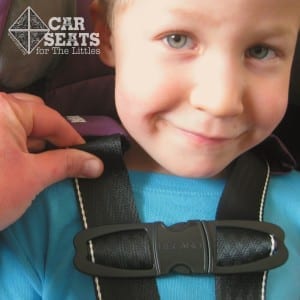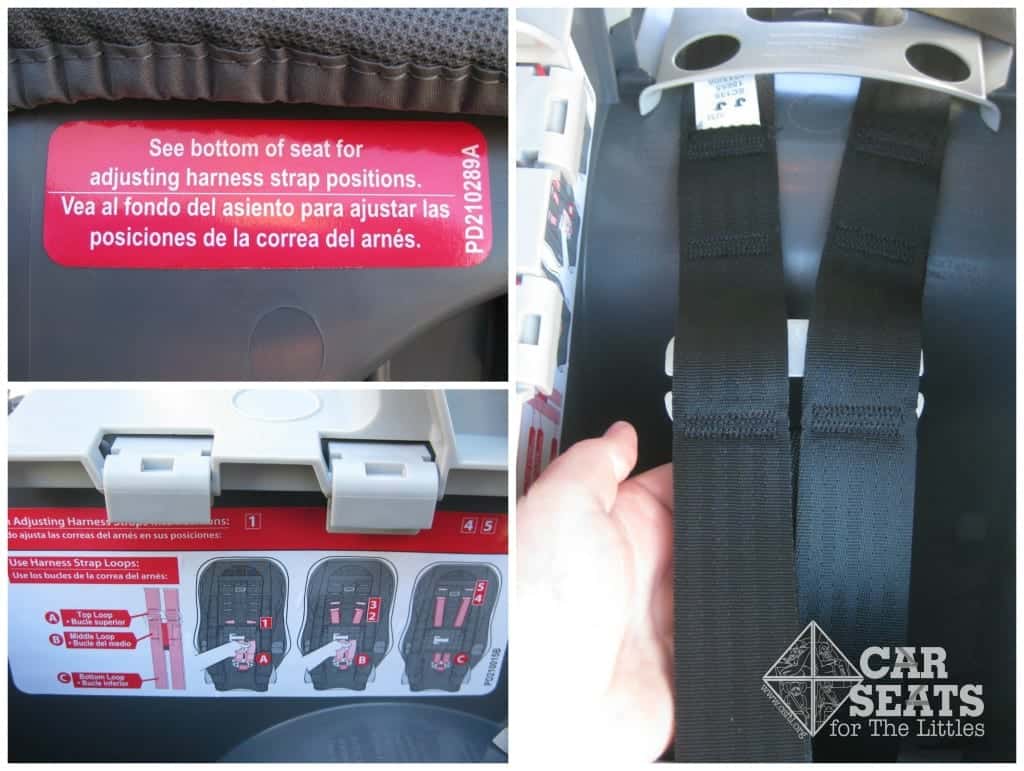A very common concern for parents is what to do when it seems that you’ve tightened your child’s car seat and the harness is uneven. One of the straps is tight but the other is still very loose. What can you do? Let’s explore a few common culprits and ways to troubleshoot them.
First, a quick review. How tight should your child’s harness be? It needs to pass the pinch test. That means if you try to grasp the straps at the child’s collarbone, the harness should be tight enough that you cannot grab and pinch the material because it sits nice and flush with the child’s torso.
Now, if you’ve strapped your child in and one strap passes the pinch test but the other does not, what is going on? Here are some things to check for:
1. The Continuous Harness

Continuous harness is common on many seats
This is probably the most common source of the “one strap too loose” problem. A continuous harness is made up of one big loop that runs under the child’s bottom. Many seats made by Dorel Juvenile Group (Safety 1st, Eddie Bauer, Cosco, Maxi Cosi) have this design, as well as Evenflo, Baby Trend, and the First Years True Fit.
Picture a set of shoelaces; in order to make the laces even you need to pull each side of the laces evenly to make sure one is not longer than the other. The same applies to a car seat with a continuous harness. To even out the straps, grasp one hip strap in each hand and pull side to side until there is equal slack in each side and then tighten appropriately.
2. The Adjustable Length Harness
In order to fit a wide variety of children, many seats have harnesses that are adjustable in length. This is done by putting multiple loops at the end of the harness to make it longer or shorter as the child grows. The manual often has specific directions about which loops to use based on the child’s weight, height, or which harness slot the child is using. Make sure to check your manual to determine those requirements, and ensure that the harness straps are threaded on the same loop. If each side is on a different length, that will cause uneven straps.
3. The Rear Adjusting Harness
Some infant seats have a harness that adjusts from the back of the seat rather than with a single pull strap on the front of the seat. In this case, each harness strap must be pulled tight individually.
4. The Hung Up Harness
The back of a car seat often has a lot of nooks and crannies where the harness can get stuck, especially with a rear facing seat. Reach your hand around the back of the seat to make sure that the splitter plate or straps are not caught on something, causing the straps to be uneven.
Tighten and release the harness adjuster a few times to ensure that nothing is caught on the harness and to “reset” the harness. Finally, move the headrest back to the correct position for the child. To prevent the issue from happening again, each time you adjust the harness, pull evenly on both straps at the same time rather than just one side at a time.
6. The Off Center Child
It’s not uncommon for toddlers to be fairly displeased when it is time to get buckled up. They have a knack for turning their limbs and torso into veritable planks that simply will not be stuffed into a car seat. Convincing a toddler to be agreeable about climbing into their car seat is a topic for a whole other blog post, but in terms of making sure their harness is evenly tight, this can be a major culprit. If the child’s body is turned to one side, scooted forward, or shifted to one side it can make the harness seem as though one side is too loose. Always make sure that the child’s bottom is all the way back in the seat and that they are centered in the seat before checking harness tightness.
Remember to always follow the manufacturer’s instructions when buckling your child into their seat or making adjustments. Reading the manual is imperative when it comes to car seat safety! If in doubt about a persistent issue, it’s a great idea to contact the manufacturer of the seat. You can also visit a CPST in your area, their hands on expertise is invaluable. Hopefully this guide has shown you a few tips and tricks you may not have thought of when it comes to making sure your child’s harness is snug before every ride.







